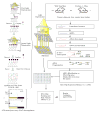Microarrays, antiobesity and the liver
- PMID: 15657555
- PMCID: PMC3651835
Microarrays, antiobesity and the liver
Abstract
In this review, the microarray technology and especially oligonucleotide arrays are exemplified with a practical example taken from the perilipin-/- mice and using the dChip software, available for non-lucrative purposes. It was found that the liver of perilipin-/- mice was healthy and normal, even under high-fat diet when compared with the results published for the scd1-/- mice, which under high-fat diets had a darker liver, suggestive of hepatic steatosis. Scd1 is required for the biosynthesis of monounsaturated fatty acids and plays a key role in the hepatic synthesis of triglycerides and of very-low-density lipoproteins. Both models of obesity resistance share many similar phenotypic antiobesity features, however, the perilipin-/- mice had a significant downregulation of stearoyl CoA desaturases scd1 and scd2 in its white adipose tissue, but a normal level of both genes inside the liver, even under high-fat diet. Here, different microarray methodologies are discussed, and also some of the most recent discoveries and perspectives regarding the use of microarrays, with an emphasis on obesity gene expression, and a personal remark on my findings of increased expression for hemoglobin transcripts and other hemo related genes (hemo-like), and for leukocyte like (leuko-like) genes inside the white adipose tissue of the perilipin-/- mice. In conclusion, microarrays have much to offer in comparative studies such as those in antiobesity, and also they are methodologies adequate for new astounding molecular discoveries [free full text of this article Online].
Figures


Similar articles
-
Coordinated upregulation of oxidative pathways and downregulation of lipid biosynthesis underlie obesity resistance in perilipin knockout mice: a microarray gene expression profile.Diabetes. 2003 Nov;52(11):2666-74. doi: 10.2337/diabetes.52.11.2666. Diabetes. 2003. PMID: 14578284
-
Probing the role of stearoyl-CoA desaturase-1 in hepatic insulin resistance.J Clin Invest. 2006 Jun;116(6):1478-81. doi: 10.1172/JCI28774. J Clin Invest. 2006. PMID: 16741573 Free PMC article.
-
Hepatic stearoyl-CoA desaturase-1 deficiency protects mice from carbohydrate-induced adiposity and hepatic steatosis.Cell Metab. 2007 Dec;6(6):484-96. doi: 10.1016/j.cmet.2007.10.014. Cell Metab. 2007. PMID: 18054317
-
Hormonal and nutritional regulation of SCD1 gene expression.Biochimie. 2011 Jan;93(1):78-86. doi: 10.1016/j.biochi.2010.08.001. Epub 2010 Aug 14. Biochimie. 2011. PMID: 20713121 Review.
-
The role of stearoyl-CoA desaturase in the control of metabolism.Prostaglandins Leukot Essent Fatty Acids. 2005 Jul;73(1):35-41. doi: 10.1016/j.plefa.2005.04.011. Prostaglandins Leukot Essent Fatty Acids. 2005. PMID: 15941655 Review.
Cited by
-
Ferroptosis is governed by differential regulation of transcription in liver cancer.Redox Biol. 2019 Jun;24:101211. doi: 10.1016/j.redox.2019.101211. Epub 2019 May 10. Redox Biol. 2019. PMID: 31108460 Free PMC article.
-
Escaping the cut by restriction enzymes through single-strand self-annealing of host-edited 12-bp and longer synthetic palindromes.DNA Cell Biol. 2012 Feb;31(2):151-63. doi: 10.1089/dna.2011.1339. Epub 2011 Sep 6. DNA Cell Biol. 2012. PMID: 21895510 Free PMC article.
-
The rules of variation: amino acid exchange according to the rotating circular genetic code.J Theor Biol. 2010 Jun 7;264(3):711-21. doi: 10.1016/j.jtbi.2010.03.046. Epub 2010 Apr 3. J Theor Biol. 2010. PMID: 20371250 Free PMC article.
References
-
- Southern EM, Maskos U, Elder JK. Analyzing and comparing nucleic acid sequences by hybridization to arrays of oligonucleotides: evaluation using experimental models. Genomics. 1992;13:1008–17. - PubMed
-
- Velculescu VE, Zhang L, Vogelstein B, Kinzler KW. Serial analysis of gene expression. Science. 1995;270:484–7. - PubMed
-
- Brenner S, Johnson M, Bridgham J, Golda G, Lloyd DH, Johnson D, Luo S, et al. Gene expression analysis by massively parallel signature sequencing (MPSS) on microbead arrays. Nat Biotechnol. 2000;18:630–4. - PubMed
-
- DeFrancesco L. Probing Protein Interactions. The Scientist. 2002;16:28.
-
- Velculescu VE, Madden SL, Zhang L, Lash AE, Yu J, Rago C, Lal A, et al. Analysis of human transcriptomes. Nat Genet. 1999;23:387–8. - PubMed
Publication types
MeSH terms
Substances
Grants and funding
LinkOut - more resources
Full Text Sources
Medical

